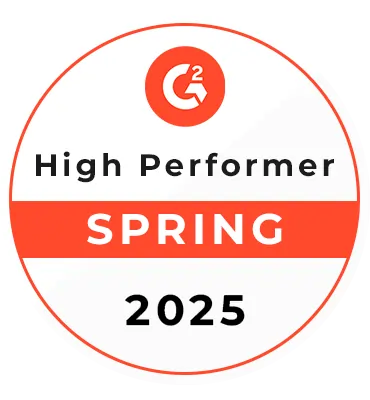How to Use Interactive Elements in Manufacturing Website to Showcase Your Products Online
Manish Kumawat
Last Updated on: 01 October 2025
A consumer's decision to buy a product might be influenced positively or negatively by the style of product presentation on your website. When products are presented well on your website, they instantly attract the viewer's attention as well as improve sales. The more you succeed in proving engagement for your manufacturing website visitors, the more you get business. That’s why integrating interactive elements into your manufacturing website is more must-do strategy. Here we discuss some techniques for improving product presentation and empowering manufacturing companies to create the best user engagement by adding interactive elements to the website.
9 Trending Interactive Elements for your Manufacturing Website 2024-2025
Let’s see the latest trends in interactive elements that manufacturers can use to showcase their products on their manufacturing websites effectively.
1. Advanced Product Configurators
Product configurators have been around for a while but are becoming more advanced and user-friendly. The latest trends in 2024-2025 incorporate artificial intelligence (AI) and machine learning (ML) to provide more personalized experiences on manufacturing websites.
- AI-Driven Recommendations
- Real-Time Visualization
- Integration with AR
Example: A machine tool configurator on a manufacturing website that adjusts tool specifications in real-time based on the user's input and suggests optimal configurations based on industry standards.
2. Interactive 3D Models and Digital Twins
Interactive 3D models are becoming more sophisticated, with the integration of digital twin technology on manufacturing websites. Digital twins are virtual replicas of physical products that are updated in real time based on data from sensors on the actual products.
- Real-Time Updates
- Detailed Visualization
- Simulation Capabilities
Example: A digital twin of an industrial robot on a manufacturing website that allows users to interact, view operational data, and simulate tasks.
3. Augmented Reality (AR) and Virtual Reality (VR)
AR and VR are no longer futuristic concepts; they are now mainstream tools that can significantly enhance the user experience on manufacturing websites.
- AR Product Previews
- VR Demonstrations
- Interactive Manuals
Example: An AR app on a manufacturing website that lets users see how a new piece of manufacturing equipment would fit into their production line, helping them make informed purchasing decisions.
4. Virtual Tours
Virtual tours are becoming more beneficial by providing users with a detailed view of manufacturing facilities.
- 360-Degree Videos
- Interactive Hotspots
- Live Virtual Tours
Example: A virtual tour of a state-of-the-art manufacturing plant on a manufacturing website with interactive hotspots that detail each stage of the production process and the technologies used.
5. Interactive Infographics and Data Visualizations
Infographics and data visualizations are becoming more dynamic and interactive, making complex information more accessible on manufacturing websites.
- Dynamic Charts
- Storytelling Elements
- Interactive Maps
Example: An interactive infographic on a manufacturing website that shows the environmental impact of different manufacturing processes, allowing users to explore data by region, process, and time period.
6. Personalized User Dashboards
Personalized dashboards are becoming more prevalent on manufacturing websites, offering users tailored experiences based on their needs and behaviors.
- Customizable Views
- Notification Systems
Example: A personalized dashboard for a manufacturing client on a manufacturing website that tracks their order history, equipment performance, and provides recommendations for upgrades and maintenance.
7. AI-powered chatbots and Virtual Assistants
AI-powered chatbots and virtual assistants are becoming more sophisticated, providing immediate and intelligent responses to user queries on manufacturing websites.
- Natural Language Processing (NLP)
- Integration with CRM
- 24/7 Support
Example: A virtual assistant on a manufacturing website that can guide users through product selection, provide detailed specifications, and even assist with placing orders.
8. Enhanced Customer Portals
Customer portals are becoming more comprehensive and interactive on manufacturing websites, providing users with a centralized hub for all their interactions with the manufacturer.
- Order Management
- Product Support
- Community Features
Example: A customer portal on a manufacturing website that includes interactive troubleshooting guides, product manuals, and a community forum for user support.
9. Interactive Training Modules
Training modules are becoming more interactive on manufacturing websites, providing users with hands-on learning experiences.
- Simulations and Scenarios
- Gamification
- Progress Tracking
Example: An interactive training module on a manufacturing website for a new piece of machinery that includes simulations of common tasks and challenges users might face.
Benefits of Integrating Interactive Elements in Manufacturing Website
- Top-class User Engagement: Interactive elements like 3D models and configurators keep users engaged and exploring your site longer.
- Precise Decision-Making: Visual product customization tools help customers make better-informed purchasing decisions by visualizing options in real-time.
- Maximum Customer Satisfaction: Personalized experiences and instant support via chatbots ensure customers feel valued and understood.
- Higher Conversion Rates: Interactive features such as AR previews enhance the shopping experience, leading to increased sales and conversion rates.
- Efficient Troubleshooting: AI chatbots and interactive manuals provide quick solutions, reducing downtime and enhancing operational efficiency.
- Better Transparency: Blockchain and virtual tours build trust by providing clear insights into manufacturing processes and product origins.
- Affordable Training: Interactive training modules reduce the need for physical training sessions, saving time and costs for manufacturers.
- Grow Customer Loyalty: Engaging and efficient online experiences foster loyalty, encouraging repeat business and positive word-of-mouth.
Technical Guide to Implementing Interactive Elements in Manufacturing Website
1. Advanced Product Configurators
- Key Technologies: JavaScript Frameworks: React.js, Vue.js, Angular.js; Backend Languages: Node.js, Python, Ruby; AI/ML Integration: TensorFlow.js, PyTorch
- Implementation Steps:
- Front-End Development: Use a JavaScript framework to build a dynamic UI. Implement real-time updates with state management libraries like Redux (for React) or Vuex (for Vue).
- Backend Development: Set up a server using Node.js or Python to handle data processing. Integrate AI/ML models.
- Visualization: Use WebGL or Three.js for real-time 3D visualization. Ensure AR capabilities using AR.js or similar libraries.
2. Interactive 3D Models and Digital Twins
- Key Technologies: 3D Modeling Software: Blender, Autodesk Maya; Web Technologies: WebGL, Three.js, Babylon.js; IoT Integration: MQTT, AWS IoT
- Implementation Steps:
- 3D Model Creation: Use software like Blender to create detailed 3D models of your products. Export models in a web-friendly format (e.g., glTF).
- Web Integration: Use Three.js or Babylon.js to render 3D models on your website. Implement interactive controls.
- Digital Twin Setup: Connect physical products to the digital twins using IoT sensors. Use MQTT or similar protocols to stream data from sensors to your backend. Update the digital twin in real time using the streamed data.
3. Virtual Reality and Augmented Reality
- Key Technologies: AR Libraries: AR.js, A-Frame; VR Frameworks: Three.js, Babylon.js, A-Frame; Mobile Support: ARKit (iOS), ARCore (Android)
- Implementation Steps:
- AR Implementation: Use AR.js to add AR capabilities to your website. Develop an AR app using ARKit or ARCore for mobile experiences.
- VR Implementation: Use A-Frame or Three.js to create VR scenes. Optimize for VR headsets like Oculus Rift or HTC Vive.
- Integration: Embed AR/VR experiences into your website. Ensure cross-platform compatibility.
4. Virtual Tours
- Key Technologies: 360-degree Video Cameras: Ricoh Theta, GoPro MAX; Web Frameworks: Pannellum, KRpano; Interactive Hotspots: HTML5, JavaScript
- Implementation Steps:
- Capture and Processing: Use 360-degree cameras to capture videos of your facility. Process videos for web display.
- Web Integration: Use Pannellum or KRpano to embed 360-degree videos on your website. Add interactive hotspots using HTML5 and JavaScript.
- Live Virtual Tours: Set up live streaming with services like Vimeo or YouTube Live.
5. Interactive Infographics and Data Visualizations
- Key Technologies: Data Visualization Libraries: D3.js, Chart.js; Backend Integration: Node.js, Python; Real-Time Data: WebSockets, REST APIs
- Implementation Steps:
- Data Collection and Processing: Collect data from various sources (e.g., IoT sensors, ERP systems). Process data on the backend using Node.js or Python.
- Visualization: Use D3.js or Chart.js to create dynamic, interactive visualizations. Implement real-time updates using WebSockets or REST APIs.
- User Interaction: Add interactive elements like filters, tooltips, and animations.
6. Personalized User Dashboards
- Key Technologies: JavaScript Frameworks: React.js, Vue.js, Angular.js; Backend Services: Node.js, Python, Ruby; Analytics Tools: Google Analytics, Mixpanel
- Implementation Steps:
- Front-End Development: Use a JavaScript framework to build a dynamic and customizable UI. Implement state management.
- Backend Integration: Set up a backend to manage user data and preferences. Integrate with analytics tools.
- User Customization: Allow users to customize their dashboard layout and widgets. Implement real-time data updates and notifications.
7. AI-powered chatbots and Virtual Assistants
- Key Technologies: NLP Libraries: TensorFlow.js, SpaCy; Chatbot Platforms: Dialogflow, Microsoft Bot Framework; Backend Services: Node.js, Python
- Implementation Steps:
- Chatbot Development: Use Dialogflow or Microsoft Bot Framework to build the chatbot. Integrate NLP capabilities using TensorFlow.js or SpaCy.
- Backend Integration: Connect the chatbot to your backend systems for data access and processing. Ensure seamless CRM integration.
- Deployment: Embed the chatbot into your website. Monitor performance and get user feedback.
8. Enhanced Customer Portals
- Key Technologies: Web Frameworks: React.js, Angular.js, Vue.js; Backend Services: Node.js, Python, Ruby; Database Management: MongoDB, PostgreSQL
- Implementation Steps:
- Front-End Development: Develop a user-friendly interface using a JavaScript framework. Implement features like order tracking, support access, and community forums.
- Backend Development: Set up a robust backend. Use databases like MongoDB.
- Security: Implement strong authentication and authorization mechanisms. Ensure data privacy and protection.
9. Interactive Training Modules
- Key Technologies: E-Learning Platforms: Moodle, Blackboard; Web Frameworks: React.js, Angular.js, Vue.js; Gamification Tools: BadgeOS, GameSalad
- Implementation Steps:
- Content Creation: Develop training content using e-learning platforms. Create interactive scenarios and simulations.
- Web Integration: Integrate the training modules into your website using JavaScript frameworks. Implement gamification elements.
- Tracking and Feedback: Track user progress and performance. Provide feedback and analytics.
Case Study of Integrating Interactive Product Showcase in Manufacturing Website
Global Industries
Fulminous Software has redesigned the old website of Global Industries website with trending interactive elements. As Global Industries, is a leading multinational manufacturing company with diverse product lines across various sectors, we used AI chatbots, virtual assistants, 3D models, and AR/VR technology to renovate their outdated website.
Challenges
- Complex Product Portfolio: Global Industries offers a wide range of products across different industries.
- User Engagement: The existing website of Global Industries lacked interactive features.
- Worldwide Audience: Catering to a global audience requires focused localization and accessibility.
Solution
Redesign Strategy
- User-Centric Design: Fulminous Software adopted a user-centric approach.
- Integration of Interactive Element s: The website was redesigned to incorporate AI chatbots, virtual assistants, 3D models, and AR/VR technology.
Key Features Implemented
- AI Chatbots and Virtual Assistants: Fulminous Software implemented AI-powered chatbots and virtual assistants to provide instant support and personalized product recommendations. Chatbots were trained to answer queries, guide users through the website, and assist with product selection.
- 3D Models: Detailed 3D models of products were created and integrated into the website, allowing users to explore products from all angles.
- AR/VR Technology: Augmented reality (AR) and virtual reality (VR) experiences were developed to provide immersive product demonstrations. Users could visualize products in their real-world environment through AR and explore virtual showrooms and facilities using VR.
Results
- Users spend an average of 33% more time exploring products and interacting with the website.
- 21% increase in conversion rates and a 24% increase in average order value.
- Reduced response time by 38%, leading to a 43% increase in customer satisfaction ratings.
- 58% increase in website traffic from international markets.
Collaborate with Fulminous to Integrate Interactive Product Showcase in Manufacturing Website
If you are looking for a tech partner to design or redesign your manufacturing website with interactive elements, Fulminous Software is the most suitable choice for you. Since 2018, Fulminous Software has been providing affordable web designing services for all types of manufacturing businesses. Collaborate with us to integrate trending features like AI chatbots, 3D models, and AR/VR technology into your manufacturing website.
FAQs
Q1: Why should my manufacturing website incorporate interactive elements like AI chatbots and 3D models?
A: Interactive elements enhance user engagement by providing personalized experiences and visualizing products in detail, leading to increased customer satisfaction and higher conversion rates.
Q2: How can augmented reality (AR) and virtual reality (VR) benefit my manufacturing website?
A: AR and VR technologies offer immersive product demonstrations and virtual tours, allowing potential customers to visualize products in real-world contexts and explore manufacturing facilities remotely.
Q3: What are the technical challenges in implementing interactive features like AI chatbots and 3D models on a manufacturing website?
A: Implementing AI chatbots requires integration with natural language processing (NLP) frameworks and backend systems. Similarly, creating and optimizing detailed 3D models for web display involves using WebGL or similar technologies for smooth rendering and interaction.
Q4: What measurable benefits can I expect from integrating interactive training modules into my manufacturing website?
A: Interactive training modules improve employee learning experiences by offering simulations and gamification. Well-designed training modules guarantee skill development for your workers, lower training expenses, and improve knowledge retention.
HIRE A TOP SOFTWARE DEVELOPMENT COMPANY

 Verified
Expert in Software & Web App Engineering
Verified
Expert in Software & Web App Engineering
I am Manish Kumawat, co-founder of Fulminous Software, a top leading customized software design and development company with a global presence in the USA, Australia, UK, and Europe. Over the last 10+ years, I am designing and developing web applications, e-commerce online stores, and software solutions custom tailored according to business industries needs. Being an experienced entrepreneur and research professional my main vision is to enlighten business owners, and worldwide audiences to provide in-depth IT sector knowledge with latest IT trends to grow businesses online.
Partner with Top-Notch Web Application Development Company!
Discuss your Custom Application Requirements on info@fulminoussoftware.com or call us on +1-903 488 7170.
15 Days Risk-Free Trial

